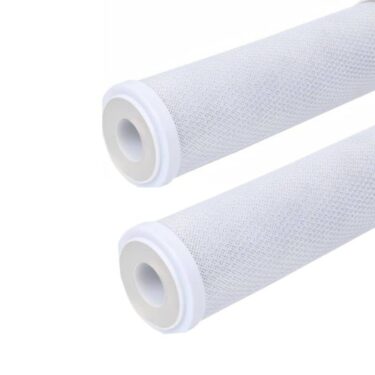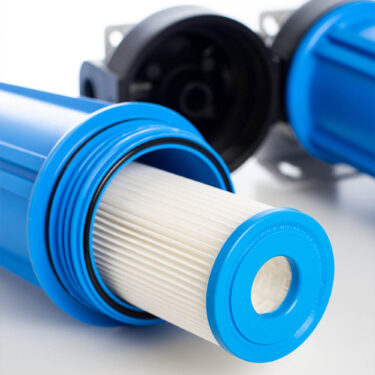Description
Automatic activated carbon filters
The activated carbon filters are designed and calculated with activated carbon with size range 12 x 40 U.S. Std. Mesh, being smaller than the 8 x 30 U.S. Std. size. Mesh diffusion rate increases, therefore the rate of dechlorination and adsorption of organic contaminants becomes faster. This means that with a smaller bed volume we can achieve the same performance of a larger bed volume of a coal with a larger particle size.
Available configurations:
Simple automatic equipment by time: Carbotecnia single tank equipment with dual loading, with manual or automatic control valve for time-controlled backwashing (every certain number of days or on a certain day of the week). Recommended for domestic or commercial use, and operation less than 23 h.
Multiple automatic equipment: This configuration is only available for premium valves with industrial control (Clack WS2H and WS3). With this option, up to 16 units can be operated.
- Parallel equipment: this option allows all filtration units to operate at the same time, unless a filter in the system is in backwashing stage. This system is programmed in such a way that when one of the equipment requires backwashing, either due to time or pressure drop, the backwashing sequence is initiated in series for all the equipment in the system, starting with the one that sent the signal.
- Progressive flow equipment: this option is ideal when water demand varies and we have peak operating flows at different times of the day. This function consists of setting a flow value at which one or more pieces of equipment will come into operation in order to meet the required flow. A flow value must be specified for the incorporation of each of the equipment in the system.
Automatic equipment with standard valves (Aquatrol electromechanical):
Code |
Tank size (in) |
Bed volume(ft3) |
Cross-sectional area (ft2) |
Service flow to dechlorinate (lpm) |
Service flow to dechlorinate (gpm) |
Service flow for potabilization (lpm) |
Service flow for drinking water treatment (gpm) |
Backwash flow (lpm) |
Backwash flow (gpm) |
Automatic Valve (Aquatrol) |
Input/Output Connections |
Connections Drainage |
|---|---|---|---|---|---|---|---|---|---|---|---|---|
P_630024 |
8×44 |
0.75 |
0.35 |
8 |
2.2 |
6.4 |
1.7 |
21.2 |
5.6 |
AQT-275FT |
1″ |
¾” |
P_630025 |
9×48 |
1 |
0.44 |
10 |
2.7 |
8.3 |
2.2 |
26.87 |
7.1 |
AQT-275FT |
1″ |
¾” |
P_630026 |
10×54 |
1.5 |
0.55 |
16 |
4.2 |
12.1 |
3.2 |
32.93 |
8.7 |
AQT-275FT |
1″ |
¾” |
P_630027 |
12×52 |
2 |
0.79 |
20 |
5.3 |
15.9 |
4.2 |
47.69 |
12.6 |
AQT-275FT |
1″ |
¾” |
P_630028 |
13×54 |
2.5 |
0.92 |
28 |
7.5 |
24.6 |
6.5 |
55.64 |
14.7 |
AQT-275FT |
1″ |
¾” |
P_630029 |
14×65 |
3 |
1.07 |
34 |
9 |
28.4 |
7.5 |
64.72 |
17.1 |
AQT-275FT |
1″ |
¾” |
P_630030 |
16×65 |
4 |
1.4 |
42 |
11 |
34.1 |
9 |
84.41 |
22.3 |
AQT-275FT |
1″ |
¾” |
P_630031 |
18×65 |
5 |
1.77 |
57 |
15 |
49.2 |
13 |
107.12 |
28.3 |
AQT-285FT |
1 ½” |
1″ |
P_630032 |
21×62 |
6.5 |
2.41 |
76 |
20 |
64.3 |
17 |
145.72 |
38.5 |
AQT-285FT |
1 ½” |
1″ |
P_630033 |
24×72 |
9 |
3.14 |
102 |
27 |
85.5 |
22.6 |
190.39 |
50.3 |
AQT-315FT |
2″ |
2″ |
P_630034 |
30×72 |
14 |
4.91 |
159 |
42 |
132.5 |
35 |
297.12 |
78.5 |
AQT-315FT |
2″ |
2″ |
Automatic activated carbon filters with premium valves (digital clack):
Code |
Tank size (in) |
Bed volume(ft3) |
Cross-sectional area (ft2) |
Service flow to dechlorinate (lpm) |
Service flow to dechlorinate (gpm) |
Service flow for potabilization (lpm) |
Service flow for drinking water treatment (gpm) |
Backwash flow (lpm) |
Backwash flow (gpm) |
Automatic digital valve (Clack) |
Input/Output Connections |
Connections Drainage |
|---|---|---|---|---|---|---|---|---|---|---|---|---|
P_630010 |
8×44 |
0.75 |
0.35 |
8 |
2.2 |
6.4 |
1.7 |
21.2 |
5.6 |
Clack WS1 |
¾” |
¾” |
P_630011 |
9×48 |
1 |
0.44 |
10 |
2.7 |
8.3 |
2.2 |
26.87 |
7.1 |
Clack WS1 |
¾” |
¾” |
P_630012 |
10×54 |
1.5 |
0.55 |
16 |
4.2 |
12.1 |
3.2 |
32.93 |
8.7 |
Clack WS1 |
¾” |
¾” |
P_630013 |
12×52 |
2 |
0.79 |
20 |
5.3 |
15.9 |
4.2 |
47.69 |
12.6 |
Clack WS1 |
¾” |
1″ |
P_630014 |
13×54 |
2.5 |
0.92 |
28 |
7.5 |
24.6 |
6.5 |
55.64 |
14.7 |
Clack WS1 |
¾” |
1″ |
P_630015 |
14×65 |
3 |
1.07 |
34 |
9 |
28.4 |
7.5 |
64.72 |
17.1 |
Clack WS1 |
¾” |
1″ |
P_630016 |
16×65 |
4 |
1.4 |
42 |
11 |
34.1 |
9 |
84.41 |
22.3 |
Clack WS1 |
¾” |
1″ |
P_630017 |
18×65 |
5 |
1.77 |
57 |
15 |
49.2 |
13 |
107.12 |
28.3 |
Clack WS1.25 |
1 ¼” |
1″ |
P_630018 |
21×62 |
6.5 |
2.41 |
76 |
20 |
64.3 |
17 |
145.72 |
38.5 |
Clack WS1.5 |
1 ½” |
1 ½” |
P_630019 |
24×72 |
9 |
3.14 |
102 |
27 |
85.5 |
22.6 |
190.39 |
50.3 |
Clack WS1.5 |
1 ½” |
1 ½” |
P_630020 |
30×72 |
14 |
4.91 |
159 |
42 |
132.5 |
35 |
297.12 |
78.5 |
Clack WS2/QC |
2″ |
2″ |
P_630021 |
36×72 |
18 |
7.07 |
204 |
54 |
170.3 |
45 |
428.08 |
113.1 |
Clack WS2H |
2″ |
2 ½” |
P_630022 |
42×72 |
32 |
9.62 |
360 |
95 |
208.2 |
55 |
582.51 |
153.9 |
Clack WS3 |
3″ |
3″ |
P_630023 |
48×72 |
40 |
12.56 |
454 |
120 |
283.9 |
75 |
761.16 |
201.1 |
Clack WS3 |
3″ |
4″ |
Components of a filter:
Fiberglass tank: Manufactured in one piece with fiberglass-lined polypropylene interior for mechanical and weather resistance. No need for external maintenance. Maximum operating pressure 150 psi.
Valve or automatic control head: It is the component that makes the raw or untreated water pass through the activated carbon bed, it includes inlet, outlet and drain connections; it allows us to change between the different service or backwashing positions, automatically programmed by time. Maximum operating pressure 125 psi.
Granular filter media:Coconut shell activated carbon Micro K 12 x 40 mesh with a minimum B.E.T. surface area of 600m2/g.
Lower distributor and distribution tube: The lower distributor or baskets are a micro-grooved element that allows for proper flow distribution in the backwash position, and operates as a physical barrier that does not allow leakage of granular media to the outlet line, in the service position. There are simple, stack type distributors or distributors with lateral tubes, spider type; their selection depends on the service and backwash flow, as well as the diameter of the tank. Its material of construction is HDPE or ABS. The central pipe is a PVC Ced pipe. 40 connecting the lower distributor to the control head or valve.
Backing gravel: 1/8 x 1/16 U.S. Std. silica backing gravel, 1/8 x 1/16 U.S. Std. Mesh. By having a micro-grooved distributor, the need to place several gravel beds of different grain size is eliminated.
Operating conditions:
- Bed height (in): 24 – 36
- Clearance height for bed expansion (%, min.): 50
- Hydraulic service load to dechlorinate (gpm/ft2): 3 – 10
- Hydraulic service load for water treatment (gpm/ft2): 1 – 6
- Hydraulic backwash load (gpm/ft2): 14 – 16
- Operating pressure: 30 – 100 psi
- Backwash: by pressure differential >10 psid. or by time every 72 hours max.
- Lifetime of granular media: 1 to 2 years
- Prefiltration: 5 microns
Activated carbon we use
By its nature, Micro K activated carbon has micropores on its entire surface, capable of adsorbing with greater efficiency organic contaminants of low molecular weight, which cause tastes and odors in water, or which are harmful for consumption, such as pesticides, disinfection by-products, hydrocarbons, etc. In addition, its high hardness compared to activated carbons of other raw materials makes it more resistant to erosion, which avoids material losses during operation. This property makes it ideal for use as a pretreatment for softening, demineralizing or reverse osmosis equipment; in such processes, the presence of suspended solids, such as carbon particles, is undesirable.
Advantages |
Applications |
|---|---|
|
|
More information:
Frequency of change of the activated carbon of a unit
Importance of backwashes and how and when to perform them?
Sanitization of activated carbon beds
Source:













































